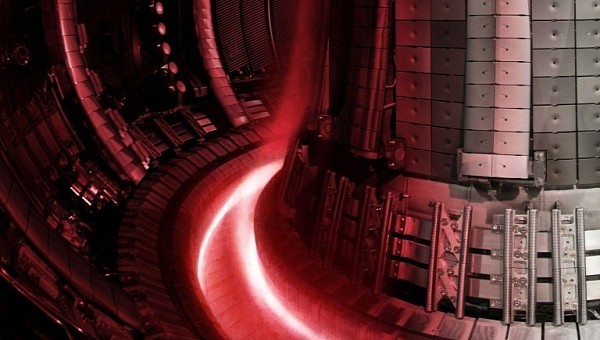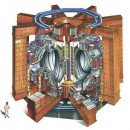The world is on the brink of an energy crisis and only one thing's for sure, fossil fuels will only satisfy for a little while longer. Humanity has some tough choices when all the dino juice is pumped out of the ground in the near future.
We could make do with solar power, wind power, or geothermal energy capture. But then we'd likely wonder why rolling blackouts and brownouts besiege the world. So to say, it's doubtful more publicized renewable energy can get the job done on their own. That's why, if we were global politicians, we'd think very seriously about doubling down on nuclear energy.
We can already hear people shouting that it's not the late 1950s anymore. Humanity's been demonstrably less cozy with the idea of nuclear energy since the Chornobyl and Three Mile Island disasters of the 1970s and 1980s made their way around global news. With that in mind, a considerable mythos of fear surrounds nuclear energy these days. If you ask us, there really shouldn't be.
Nuclear energy plants have evolved in leaps and bounds since the 20th century. Barring freak accidents caused by mostly unpredictable earthquakes, hardly any significant nuclear accidents are worth mentioning. Furthermore, we have a fair few more options when it comes to building nuclear reactors than we did 40 years ago.
For decades, the only form of practical nuclear energy came from fission reactions. Be it Three Mile Island, Chornobyl (Chernobyl), or really any non-experimental, commercial nuclear reactor made between the 1950s and today uses fission as its guiding principle. If you've yet to pay attention, nuclear fusion is joining the party.
Thanks to California's National Ignition Facility, scientists achieved what's known as scientific breakeven. A point where a nuclear fusion reaction outputs more energy than was input to create the reaction. With once-impossible levels of technology soon to be at our disposal, the human race is strapped for choice when it comes to building our nuclear-powered future.
While nuclear fusion is still at least a decade away from practical applications, it's clear modernized fission reactors will be the primary path forward. At least for the near future, that is. But keep something in mind if you're still on the fence about nuclear energy. Modern nuclear fission reactors are quite different from Chornobyl.
For one thing, only two of the RBMK-series reactors famous for blowing up at Chornobyl have been built since that fateful day in 1986. One is the Ignalina-2 in Lithuania, and the other the Smolensk Nuclear Power Plant in Russia. Neither plant has experienced a nuclear meltdown in the last four to five decades.
Modern western light-water neutron reactors (LWR) don't have the same safety feature shutdown capabilities that Soviet RBMK reactors used to change nuclear fuel rods without shutting off the reactor. Thus practically eliminating preventable nuclear accidents caused by human error during refueling, the likes of Chornobyl. Though this reduces an LWRs power output during fuel-rod replacement, the result is a reactor with very little chance of ever melting down or getting out of control.
As many as four generations of nuclear fission reactors have been designed worldwide since the 1950s if one counts more modern gen-III+ reactors built recently. Fission reactors have more variety than could ever be covered in one article. Be it in nuclear fuel options, types of moderator material, and operating principles. But if you're searching for the really big fish, fusion has its options too.
The most famous experimental type of nuclear fusion is the Tokamak-style reactor. This is the style of reactor the National Ignition Facility used to reach a scientific breakeven factor of 1.5 in December 2022. It also held the record for the most power generated by a fusion reaction of 59 megajoules at the Joint European Torus (JET) laboratory in Oxfordshire, United Kingdom.
Even unproven fusion reactors like Helion Energy's sixth-generation Trenta are still managing to prove that small form-factor, highly nuclear energy fusion is indeed possible. Doing so by forming two rings of highly energized plasma, then smashing them together without the need for high-pressure water jackets to generate steam like Tokamak fusion reactors and many types of fission reactors.
Helion's upcoming seventh-gen Polaris reactor will use fiber-optic electricity capture to prove definitively how much power this novel form of fusion reaction can generate. If you ask us, this is bound to be the most exciting advancement in nuclear fusion technology since scientific breakeven.
With so many varieties of nuclear reactors to cover, what it means for us at the end of the day is that propaganda's significantly altered humanity's perspective of nuclear energy over the years. The notion that its widespread use would lead to an inevitable catastrophe, though pervasive as it once was, is slowly being drowned out under a sea of technological innovation.
Though we wouldn't blame people for being slightly nervous living around a nuclear reactor, let us remind you that folks have been living near oil refineries, petrochemical-burning powerplants, and gas stations since time immemorial without much complaint. With this in mind, we really think people should change their attitudes towards nuclear energy. Lest the oil runs out, and we're left without a viable alternative. What matters the most in all this is keeping an open mind and not letting the propaganda tell us otherwise.
We can already hear people shouting that it's not the late 1950s anymore. Humanity's been demonstrably less cozy with the idea of nuclear energy since the Chornobyl and Three Mile Island disasters of the 1970s and 1980s made their way around global news. With that in mind, a considerable mythos of fear surrounds nuclear energy these days. If you ask us, there really shouldn't be.
Nuclear energy plants have evolved in leaps and bounds since the 20th century. Barring freak accidents caused by mostly unpredictable earthquakes, hardly any significant nuclear accidents are worth mentioning. Furthermore, we have a fair few more options when it comes to building nuclear reactors than we did 40 years ago.
For decades, the only form of practical nuclear energy came from fission reactions. Be it Three Mile Island, Chornobyl (Chernobyl), or really any non-experimental, commercial nuclear reactor made between the 1950s and today uses fission as its guiding principle. If you've yet to pay attention, nuclear fusion is joining the party.
Thanks to California's National Ignition Facility, scientists achieved what's known as scientific breakeven. A point where a nuclear fusion reaction outputs more energy than was input to create the reaction. With once-impossible levels of technology soon to be at our disposal, the human race is strapped for choice when it comes to building our nuclear-powered future.
While nuclear fusion is still at least a decade away from practical applications, it's clear modernized fission reactors will be the primary path forward. At least for the near future, that is. But keep something in mind if you're still on the fence about nuclear energy. Modern nuclear fission reactors are quite different from Chornobyl.
For one thing, only two of the RBMK-series reactors famous for blowing up at Chornobyl have been built since that fateful day in 1986. One is the Ignalina-2 in Lithuania, and the other the Smolensk Nuclear Power Plant in Russia. Neither plant has experienced a nuclear meltdown in the last four to five decades.
Modern western light-water neutron reactors (LWR) don't have the same safety feature shutdown capabilities that Soviet RBMK reactors used to change nuclear fuel rods without shutting off the reactor. Thus practically eliminating preventable nuclear accidents caused by human error during refueling, the likes of Chornobyl. Though this reduces an LWRs power output during fuel-rod replacement, the result is a reactor with very little chance of ever melting down or getting out of control.
As many as four generations of nuclear fission reactors have been designed worldwide since the 1950s if one counts more modern gen-III+ reactors built recently. Fission reactors have more variety than could ever be covered in one article. Be it in nuclear fuel options, types of moderator material, and operating principles. But if you're searching for the really big fish, fusion has its options too.
The most famous experimental type of nuclear fusion is the Tokamak-style reactor. This is the style of reactor the National Ignition Facility used to reach a scientific breakeven factor of 1.5 in December 2022. It also held the record for the most power generated by a fusion reaction of 59 megajoules at the Joint European Torus (JET) laboratory in Oxfordshire, United Kingdom.
Even unproven fusion reactors like Helion Energy's sixth-generation Trenta are still managing to prove that small form-factor, highly nuclear energy fusion is indeed possible. Doing so by forming two rings of highly energized plasma, then smashing them together without the need for high-pressure water jackets to generate steam like Tokamak fusion reactors and many types of fission reactors.
Helion's upcoming seventh-gen Polaris reactor will use fiber-optic electricity capture to prove definitively how much power this novel form of fusion reaction can generate. If you ask us, this is bound to be the most exciting advancement in nuclear fusion technology since scientific breakeven.
With so many varieties of nuclear reactors to cover, what it means for us at the end of the day is that propaganda's significantly altered humanity's perspective of nuclear energy over the years. The notion that its widespread use would lead to an inevitable catastrophe, though pervasive as it once was, is slowly being drowned out under a sea of technological innovation.
Though we wouldn't blame people for being slightly nervous living around a nuclear reactor, let us remind you that folks have been living near oil refineries, petrochemical-burning powerplants, and gas stations since time immemorial without much complaint. With this in mind, we really think people should change their attitudes towards nuclear energy. Lest the oil runs out, and we're left without a viable alternative. What matters the most in all this is keeping an open mind and not letting the propaganda tell us otherwise.




















